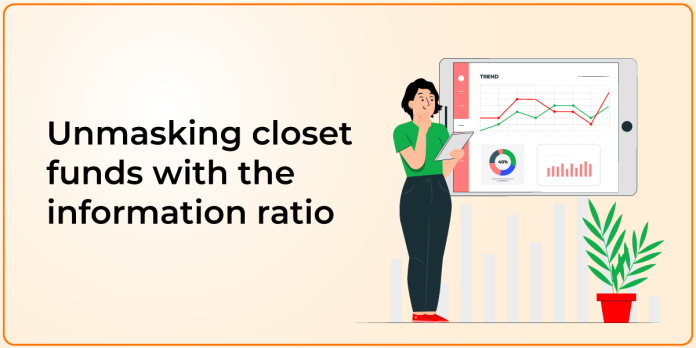Imagine a world where wolves wear designer suits and mingle with Wall Street sheep, pretending to be one of their own. These wolves are closet funds, masquerading as actively managed funds while secretly mimicking an index, leaving investors fleeced of their fees. But fear not, intrepid investors! We have a secret weapon – the Information Ratio (IR), a financial sleuth ready to reveal their true nature.
So, how do these closet funds operate?
They typically invest in most, if not all, the components of a popular index but tweak their portfolios slightly – a dash of extra spice here, a pinch of contrarian flavor there. This way, they maintain a decent performance that vaguely resembles their target index, enough to fool some investors. But their active returns, the returns exceeding the benchmark, are usually negligible, bordering on non-existent.
That’s where the Information Ratio steps in, this financial Sherlock Holmes. It compares the active return of a fund to its tracking error and the volatility of its deviation from the index. Think of it as measuring the detective’s success in solving cases (active return) against the number of wrong turns taken (tracking error). A high IR indicates a skilled detective, consistently solving cases with minimal detours. Conversely, a low IR, close to 0, screams closet fund – all bark, no bite!
Read: Key Mutual Fund Ratios
So, how can you use this financial sleuthing tool to spot a closet fund?
Check the IR: Look for funds with consistently low IRs, ideally below 0.5.
Compare Active Returns: Analyse the fund’s performance against its benchmark index. Significant underperformance is a red flag.
Track Holdings: Investigate the fund’s portfolio composition. High overlap with the index suggests passive mimicking.
Scrutinize Fees: Be wary of high fees for seemingly passive management.
Hypothetical Example
Case Study: The Camouflaged Chameleon – Exposing a Potential Closet Fund
Introducing “A-star Active Alpha Fund” (AAA): A seemingly dynamic equity fund promising investors superior returns through its “unique, research-driven investment approach.” AAA boasts a charismatic fund manager with a stellar reputation and consistently achieves performance just shy of its benchmark index. Sounds impressive, right?
But, let’s peel back the layers and see what lurks beneath the surface:
Information Ratio: AAA’s IR consistently hovers around 0.4, significantly lower than the industry average for actively managed funds.
This suggests minimal active return beyond simply mimicking the broader market.
Tracking Error: AAA’s tracking error is surprisingly low, consistently remaining within 0.2% of its benchmark index.
This implies a near-perfect replication strategy, raising suspicions about genuine active management.
Portfolio Analysis: A closer look reveals that AAA’s top holdings almost entirely overlap with the index it tracks. While slight variations exist, they appear insignificant and unlikely to generate substantial alpha.
Fees: Despite its passive-like behavior, AAA charges hefty management fees typically associated with active management. This creates a significant disparity between the value delivered and the fees incurred.
The Verdict: All evidence points towards AAA being a potential closet fund, cleverly disguised as an active champion. Its low IR, negligible tracking error, and index-hugging portfolio raise red flags about its genuine active management capabilities.
By diligently applying these investigative techniques, you can unmask the wolves in sheep’s clothing and avoid paying premium fees for mediocre index-hugging performance.
Disclaimer: This blog has been written exclusively for educational purposes. The securities mentioned are only examples and not recommendations. It is based on several secondary sources on the internet and is subject to changes. Please consult an expert before making related decisions.


